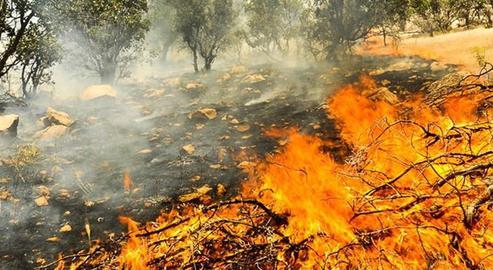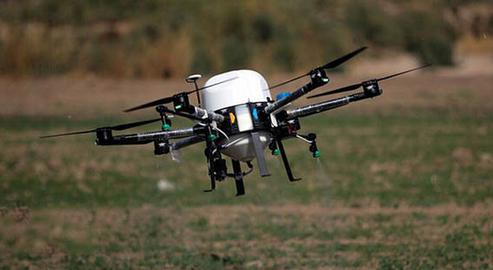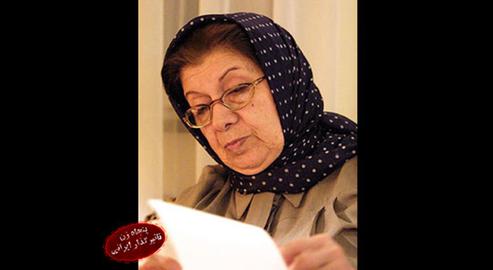On May 21, the director-general of the Natural Resources Bureau of the southwestern province of Kohkiluyeh and Boyer Ahmad said that modern equipment, including helicopters and monitoring stations, were urgently needed to protect its forests and grasslands.
Just one day later, wildfires assaulted the forests in this province and burned for eight days, turning huge swathes of these forests into ashes.
The forest area of Gachsaran was the first to be struck. Ali Khavan, the city’s governor, reported that both the people and state forces had tried to put out the fires in three areas, but were defeated by strong gusts of wind every time. Then, as wildfires were consuming oak forests and grasslands in Gachsaran, fires also broke out in the forests of Dashtestan and the highlands of Bushehr province, continuing for two full days. Then it was the turn of the protected area of Khaeez in Kohkiluyeh and Boyer Ahmad, home to many rare species of wildlife and plants.
Helicopters Came, But Too Late
Nowadays, when wildfires break out in mountainous areas, local officials immediately ask the military and crisis management bodies to send them helicopters: both to help firefighters on the ground and to spray water over the fire. This time around, the same request was made. But the helicopters either did not arrive, arrived late or were grounded due to technical problems.
On the first day of the blaze in the Dashtestan highlands, Gholamreza Montazeri, director-general of the Natural Resources Bureau of Bushehr, said the fires were covering a wide area and could not be contained without helicopters.
The next day, after protracted discussions, one helicopter arrived. But according to Montazeri, technical faults and a lack of fuel meant it was not able to do anything useful. By the time the issues were resolved, night had fallen and the helicopter returned to Bushehr’s airport. Montazeri says that the next day the helicopter returned but, again, it was grounded because of technical difficulties.
Earlier, two army helicopters and one helicopter from the National Oil Company had flown to Gachsaran to help put out forest fires. But they arrived late, by which time trees and grasslands had already been destroyed.
The protected area of Khaeez was the next to go up in flames. Asadollah Hashemi, director general of that province’s Natural Resources Bureau, said he too had requested firefighting helicopters but, as of Saturday, May 30, nothing had arrived.
The lack of resources and equipment not only makes it more difficult to put out the fires but puts the lives of relief workers and volunteers in danger. On May 29, announcing that fire in Khaeez had reached the point of a severe crisis, Mohammad Ali Arous, the deputy governor of Kohkiluyeh, reported that group of firefighters had been surrounded by fire and – as the flames were running wild and they had no water – were at risk of death.
A journalist and environmental activist, who asked not to be named, told IranWire helicopters are desperately needed in these areas because they are mountainous and difficult to cross, and fires cannot be put out with the inadequate equipment at the disposal of the firefighters traveling on foot. They said a bilateral agreement between the armed forces and the National Forests, Rangelands and Watershed Management Organization and Environmental Protection Agency should empower the latter to ask for helicopters in case of such fires. But in practice, these requests are delayed by bureaucracy.
Ali Abbasnejad, commander of the Forest Management Organization’s Protection Division, said the Ministry of Defense used to provide his organization with firefighting helicopters but for the past two years, the government has allocated no budget for this and the ministry has stopped co-operating with them.
A Protective Shield, Extensively Damaged
The three areas of Gachsaran, Khaeez and Dashtestan where the wildfires started around 10 days ago are part of the forests and grasslands of the southern Zagros Mountains, a long mountain range to the west of Iranian plateau, and are ecologically very significant to this part of Iran.
Mohammad Darvish, an ecologist and a member of the Research Institute of Forests and Rangelands’ scientific arm, told IranWire that the forest habitats of south Zagros are in fact a kind of border between two ecosystems: the arid areas, and the forest areas to the north.
“The areas that straddle such borders are a kind of ecotone and more vulnerable,” he says. “In the same way that if the border guards of a country collapse, that country becomes vulnerable, the damage to the forest shield in the border areas of south Zagros can quickly endanger the resilience of the whole Zagros habitat.”
Darvish says the border areas of south Zagros are also consequential because these areas are the most important sources of water for the wetland basins of Maroon, Zohreh, Kheirabad and Jarrahi. These areas contribute to biodiversity in other parts of Zagros. They appeared when climate was favorable, he says, but now, because of climate change, if these trees are destroyed there is little chance they will be replaced.
The conservation area of Khaeez has its own outstanding features. With an area of more than 33 thousand hectares, it is home to a vast variety of plants and trees such as oak, wild pistachio, wild almond, thyme, astragalus, medicinal herbs and a variety of flowering plants known as gramineae. Its fauna include wild goats, wolves, hyenas, jackals, foxes, porcupines, wild boars, wild cats, leopards, partridges, owls, barbary falcons and kestrel falcons.
The southern areas of the Zagros mountain range are also a very important sources of oxygen. They increase the specific heat capacity, decrease the temperature difference between day and night and make the area more habitable. Darvish says that both officials and locals must do their best to protect these areas from pestilences, timber smuggling, fires and repurposing of the land for grazing.
Nevertheless, southern areas of Zagros burned for close to 10 days. The fires severely damaged this protective shield. Some 300 hectares of Gachsaran’s forests and 200 hectares of Khaeez’s forests have now turned to ashes.
Who are the Culprits?
Every year, with the onset of the dry season, Iran’s forests are struck by wildfires. According to Mohammad Darvish, fires normally destroy between 20,000 to 50,000 hectares of forests and grasslands in Iran each year, and can start for many different reasons.
According to the director-general of Kohkiluyeh and Boyer Ahmad’s Environmental Protection Agency, the fire in Khaeez was caused by a fight between two local cattle farmers. The environmental activists also said fights between farmers are often the cause of fires in these areas.
Other incidents can start these devastating fires as well, from careless drivers who tossing cigarette butts out of the window to littering, with glass bottles working like a magnifying glass under the sun and set the dry grass to fire. “It is very important for concerned organizations to teach people and travelers about the consequences of such actions,” says Darvish.
Darvish adds that members of these organizations and volunteers should be monitoring the situation so they can sound the alarm as soon as a fire starts: 90 percent of fires, he claims, would not spread if they were identified and thus put out immediately. In addition, if the government provided volunteers with equipment such as backpack spray pumps, fire extinguishers, fire-resistant outfits, leaf blowers and appropriate boots, they could play an effective role alongside professional firefighters.
Counter-intuitively, if there were more rain in Iran at this time of year, more grass would grow and this would increase the number of fires. According to Darvish, in southern areas of Zagros where the regeneration of forests has been disrupted due to climate change, the regrowth of burned or damaged forest is possible only if the government enforces strict policies: for instance, a 10-year ban on cattle and sheep grazing in these areas.
Perhaps then, and only then, we might be able to forget the heart-rending images of recent wildfires: the burned bodies of birds and squirrels, chicks that have taken refuge in the cracks in cliff faces, and herds of wild boar running up and down between two mountains to escape death by fire.
visit the accountability section
In this section of Iran Wire, you can contact the officials and launch your campaign for various problems


























comments